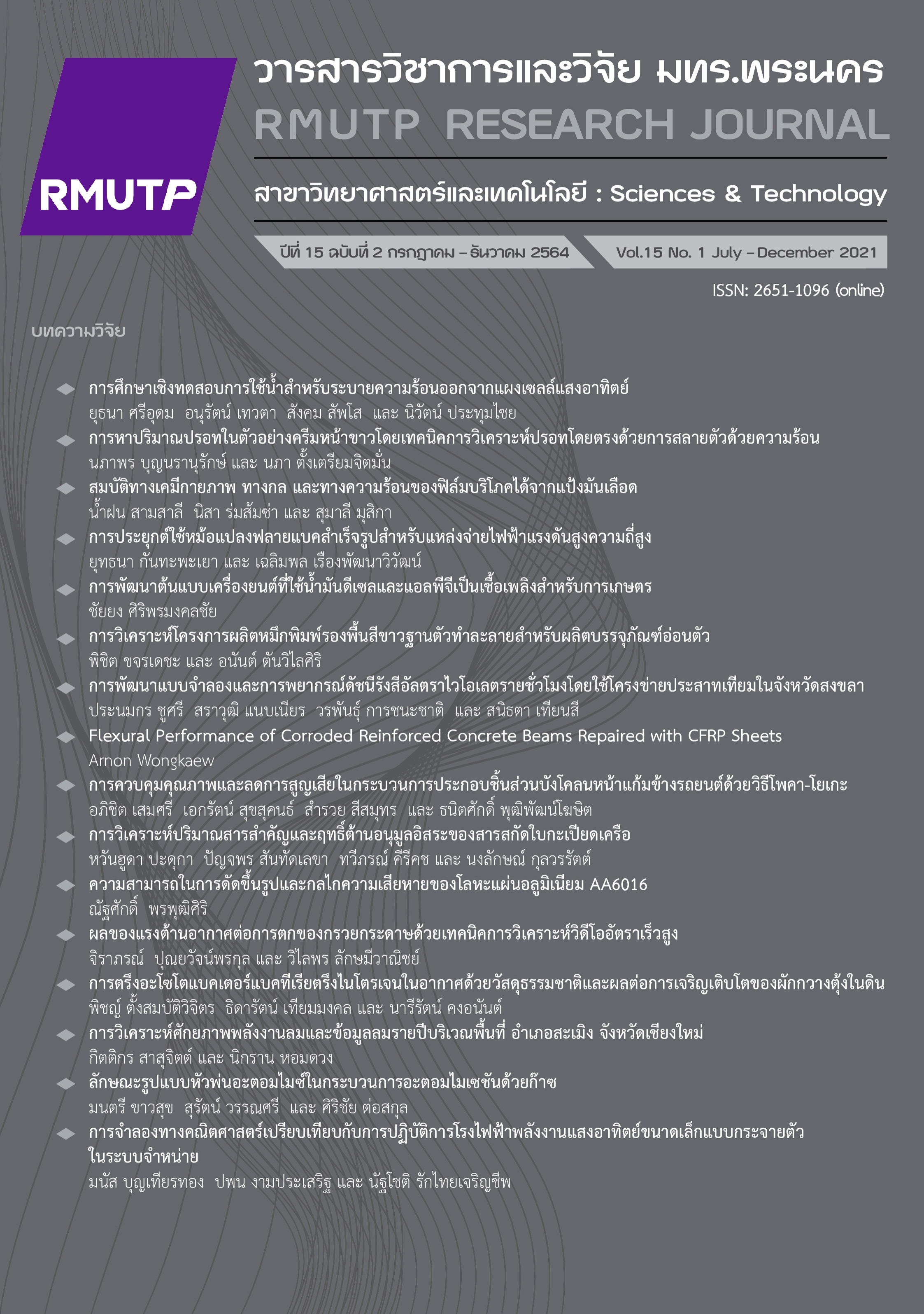Characteristics of Atomizer Nozzle in Gas Atomization
Main Article Content
Abstract
This research article aims to study of the atomizer nozzle pattern in the gas atomization process. The production of metal powder by using a gas atomization process. It is the most popular process. This process is used in various industry and engineering application. However, there is lack of information on the production of various precious metal powders in the jewelry manufacturing industry both in the country and abroad. For this reasons, the research team is interested in applying this process for the Thai jewelry manufacturing industry. Currently, the jewelry industry is in a transitional period of manufacturing technology with an increased focus on powder metallurgy technology. The production of metal powder by using a gas atomization process consisting of the following 3 steps: melting, making of atomized molten metal, cooling and solidifying for solid particles under a controlled gas atmosphere. Factors affecting particle shape, particle size, and particle size distribution are consisting of inert gas type, molten metal temperature, and the configuration or pattern of the nozzle that are different characteristics. The results can be concluded that Close-Coupled Nozzle is the most suitable nozzle for production due to the highest productivity providing the smallest particle size and spherical granular shape. The information from this study will be useful for the Thai jewelry manufacturing industry.
Article Details

This work is licensed under a Creative Commons Attribution-NonCommercial-NoDerivatives 4.0 International License.
ลิขสิทธ์ ของมหาวิทยาลัยเทคโนโลยีราชมงคลพระนครReferences
K. Fakpan, “Production of Tin Powder by Gas Atomization Process”, M.S. thesis, Depart. Materials Technology, King Mongkut's University of Technology Thonburi, Thailand, 2007.
Thermal Spray Technology. (2020, september 18), Thermal Spray Technology.mov, [Online] Available: https://www.youtube.com/watch?v=ah9kLdUFDQY,2563
N. Meemongkol, “Powder metallurgy,” University textbook, Songkla: Department of industrial engineering, Faculty of engineering Prince of Songkla University, 2005.
V.M. Leo Antony and Ramana G, Reddy. “Processes for Production of High-Purity Metal Powders,” JOM, vol. 55, pp. 14–18, 2003.
S. Boonme. “Teaching Publications 431328 Powder Metallurgy,” School of Metallurgical Engineering, Institute of Engineering, Suranaree University of Technology, 2020.
Material Technology Innovations Co., Ltd. (2020, September 18). Gas Atomization. [Online]. Available: http://www.mtinnov.
com/index.php?ac=article&at=list&tid=14
D. Kopeliovich. (2020, September 18). Water atomization. [Online]. Available: https://
www.substech.com/dokuwiki/doku.php?id=powder_preparation
P. Sungkhaphaitoona, S. Wisutmethangoonb and T. Plookpho, “Influence of Process Parameters on Zinc Powder Produced by Centrifugal Atomisation,” Materials Research, pp. 718-724, 2017.
P. Sungkhaphaitoon, “Production of Lead-Free Solder Powder by Atomization Process,” Burapha Science Journal, vol. 21 Jan.–Apr. 2016.
A. S. Baskoro, S. Supriadi and Dharmanto, “Review on plasma atomizer technology for metal powder,” in Proceeding of MATEC web of conferences 269, 05004, 2019.
P. Bunnaul, S. Wisutmethangoon and L. Sikong, “Design and construction of gas atomizer for making metal powder,” Research, Prince of Songkla University, 2545.
R. M. German. Powder metallurgy sciences. 2nd ed. New Jersey: MPIF; 1994.
D. Singh, S. C. Koria and R. K. Dube, “Study of Free-Fall Gas Atomization of Liquid Metal to Produce Powder,” Powder Metallurgy, vol. 44, no. 2, pp, 177–184, 2001.
W. G. Hopkins, “Fine Powder, Close or Open Die Atomization,” Metal Powder Report, vol. 45, no. 1, pp, 41–42, 1990.
Powder metallurgy is the manufacturing, (2563, October 28).Networks. [Online]. Available:http://thelibraryofmanufacturing.com/powder_processes.html
G. G. Nasr, A. J. Yule and L. Bendig, Industrial Sprays and Atomization: Design, Analysis and Applications. New York, 2002.
B. Zheng, Y. Lin, Y. Zhou and E. J. Lavernia, “Gas atomization of amorphous aluminum powder: Part II,” Metallurgical and Materials Transactions B., vol. 40, no. 6, pp, 995-1004, 2003.
O. Hong-wu, C. Xin and H. Bai-yun, “Influence of melt superheat on breakup process of close-coupled gas atomization,” Transactions of Nonferrous Metals Society of China, vol. 17, no. 5, 967-973, Oct. 2007,
J. B. See and G. H. Johnston, “Interactions Between Nitrogen Jets and Liquid Lead and Tin Streams,” Powder Technology, vol. 21, pp. 119-133, 1978.
D. Singh and S. Dangwal, “Effects of process parameters on surface morphology of metal powders produced by Free-Fall gas atomization,” J. MATER SCI., vol. 41, pp. 3853–3860, 2006.
M. D. Goudar, V. C. Srivastava and G. B. Rudrakshi, “Effect of Atomization Parameters on Size and Morphology of Al-17Si Alloy Powder Produced by Free-Fall Atomizer,” Engineering Journal, vol. 21, no. 1, pp. 155-168, 2016.
S. Thamprakon, S. Torsakul and S. Wannasri, “Influence of Melt Metal Pouring Temperature and Gas Flow Rate affecting 925 Sterling Silver Powder Particles,” in Proceedings of the 9nd National and International research conference on Local & Global Sustainability: Meeting the Challenges & Sharing the Solutions. March 20, 2018, Suan Sunandha Rajabhat University.
S. Ozbilen, “Influence of atomising gas pressure on particle shape of Al and Mg Powders,” Powder Technology, vol. 102, pp. 109–119, 1999.
L. Achelis and V. Uhlenwinkel, “Characterisation of metal powders generated by a pressure gas atomizer,” Materials Science and Engineering A, vol. 477, pp. 15–20, 2008.
A. M. Mullis, I. N. McCarthy and R. F. Cochrane, “High Speed imaging of the flow during Close-Coupled gas atomization: Effect of melt delivery nozzle geometry,” Journal of Materials Processing Technology, vol. 211, pp. 1471–1477, 2011.
V. C. Srivastava and S. N. Ojha, “Effect of aspiration and gas–melt configuration in close coupled nozzle on powder productivity,” Powder Metallurgy, vol. 49, no. 3, pp. 211-218, 2014.
C. Si, “Characteristics of 7055Al alloy powders manufactured by gas-solid two-phase atomization A comparison with gas atomization process,” Materials and Design, vol. 118, pp. 66–74, 2017.
Department of International Trade Promotion Ministry of Commerce. (2021, May 10). Information about the export situation of gems and jewelry. (January - December 2020). [Online]. Available: https://www.ditp.go.com


